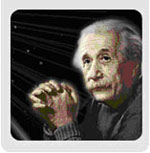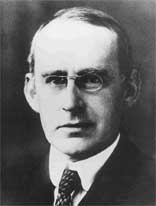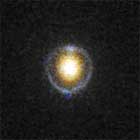
Sun-Earth Day Presents: Eclipse, In a Different Light
Extraordinary claims require extraordinary evidence, and it's hard to think of something more extraordinary than the idea that massive objects warp space and time. Yet in 1915, Albert Einstein made just this claim in his General Theory of Relativity.
EDDINGTON'S TEST OF GENERAL RELATIVITY
M. Bobrowsky 03.13.2006

Einstein had already published his Theory of Special Relativity, describing how an object's motion could cause space and time to change. Later, for General Relativity, he defined the concept of an "equivalence principle," wherein the effects of gravity are the same as those felt in an accelerating vehicle. For example, if you're in a rocket in outer space accelerating at one g, it would feel exactly like you're standing on Earth.
So, if gravity and acceleration are equivalent, and motion affects space and time, then gravity should also affect space and time. One effect of gravity is the warping of space and time around massive objects such as the sun. To test his theory, Einstein proposed observing how light from distant stars follows curved paths as it passes close to the sun. But this could be seen only during a total solar eclipse.
 Credit: Jose Wudka
Credit: Jose Wudka
Four years after Einstein published the theory of general relativity, another physicist, Arthur Eddington, went to Principe Island off the coast of Africa to photograph stars near the sun during a total eclipse on May 29, 1919. Soon afterwards, Eddington and his collaborators announced that their observations supported Einstein's theory.

Sir Arthur Eddington, Photo courtesy American Institute of Physics Niels Bohr Library
Einstein became an overnight celebrity, as newspaper headlines proclaimed, "Revolution in Science" and "Einstein Theory Triumphs." Since then, his general theory of relativity has been tested and supported many times. For example, with space-based telescopes, astronomers see how light from a distant galaxy appears as a ring when the light path bends as it travels through the curved space near another galaxy.

The discovery that massive objects warp space and time, actually has everyday applications. For example, the GPS (Global Positioning System) devices used in automobile navigation systems make use of both special and general relativity, because the GPS satellite clocks run more slowly in space owing to the clocks' motion and to their being in a different (weaker) part of the earth's gravitational field.
Eddington's 1919 observation of light bending around the sun provided early support for the Theory of General Relativity, which has since passed every test put to it. With each test and application of the theory, we gain a clearer understanding of how space and time behave both on our own planet and out amidst the stars and galaxies.
News and Events
HOT SPOTS
Eclipse Fact
From the Earth's surface, the Sun's corona ("crown") can ONLY be seen during a total eclipse.

